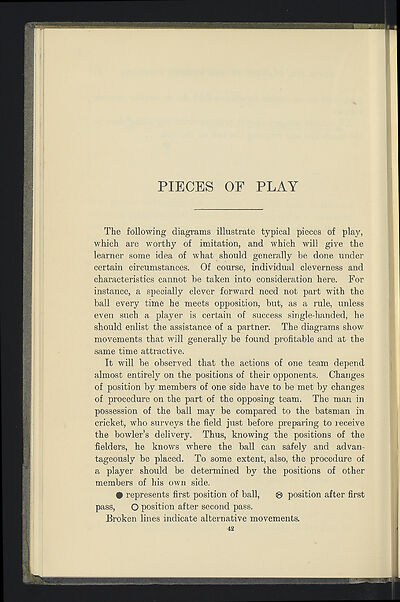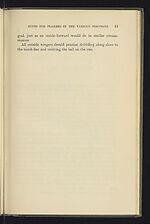Download files
Complete book:
Individual page:
Thumbnail gallery: Grid view | List view

PIECES OF PLAY
The following diagrams illustrate typical pieces of
play,
which are worthy of imitation, and which will give the
learner some idea of what should generally be done under
certain circumstances. Of course, individual cleverness and
characteristics cannot be taken into consideration here. For
instance, a specially clever forward need not part with the
ball every timo he meets opposition, but, as a rule, unless
even such a player is certain of success single-handed, he
should enlist the assistance of a partner. The diagrams show
movements that will generally be found profitable and at the
same time attractive.
It will be observed that the actions of one team depend
almost entirely on the positions of their opponents. Changes
of position by members of one side have to be met by changes
of procedure on the part of the opposing team. The man in
possession of the ball may be compared to the batsman in
cricket, who surveys the field just before preparing to receive
the bowler's delivery. Thus, knowing the positions of the
fielders, he knows where the ball can safely and advan-
tageously be placed. To some extent, also, the procedure of
a player should be determined by the positions of other
members of his own side.
• represents first position of ball, ® position after first
pass, O position after second pass.
Broken lines indicate alternative movements.
42
The following diagrams illustrate typical pieces of
play,
which are worthy of imitation, and which will give the
learner some idea of what should generally be done under
certain circumstances. Of course, individual cleverness and
characteristics cannot be taken into consideration here. For
instance, a specially clever forward need not part with the
ball every timo he meets opposition, but, as a rule, unless
even such a player is certain of success single-handed, he
should enlist the assistance of a partner. The diagrams show
movements that will generally be found profitable and at the
same time attractive.
It will be observed that the actions of one team depend
almost entirely on the positions of their opponents. Changes
of position by members of one side have to be met by changes
of procedure on the part of the opposing team. The man in
possession of the ball may be compared to the batsman in
cricket, who surveys the field just before preparing to receive
the bowler's delivery. Thus, knowing the positions of the
fielders, he knows where the ball can safely and advan-
tageously be placed. To some extent, also, the procedure of
a player should be determined by the positions of other
members of his own side.
• represents first position of ball, ® position after first
pass, O position after second pass.
Broken lines indicate alternative movements.
42
Set display mode to:
![]() Universal Viewer |
Universal Viewer | ![]() Mirador |
Large image | Transcription
Mirador |
Large image | Transcription
Images and transcriptions on this page, including medium image downloads, may be used under the Creative Commons Attribution 4.0 International Licence unless otherwise stated. ![]()
| Sports publications > How to play association football, etc > (46) |
|---|
| Permanent URL | https://digital.nls.uk/231821377 |
|---|
| Description | More than 230 sports publications from the National Library of Scotland's collections. Featured sports include football, rugby, golf, shinty, athletics, bowls, cricket and hockey. Among the material from the late 19th and early 20th centuries are match programmes, club histories, and handbooks. From the late 20th century are promotional materials to encourage greater diversity in sport. Most items cover sports activities in Scotland. There are also publications relating to the Olympics and international matches. |
|---|---|
| Additional NLS resources: |
|

